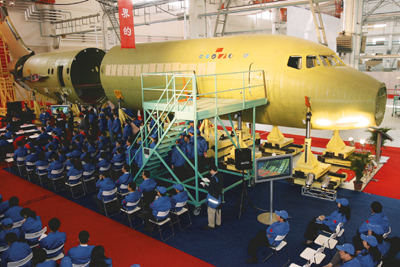
China could see its first jumbo jet spread its wings as early as 2020, according to Liu Daxiang, a senior consultant of the research and development department of China Aviation Industry Corp. I (AVIC I), one of the country’s largest aircraft developers.
Although China’s aviation industry has been developing for 55 years, the civil aviation industry still mainly functions as a parts supplier for Boeing and Airbus.
With Boeing and Airbus taking the lion’s share in the international market, China has had to steadily increase its imports of Boeing and Airbus airliners to meet the demands of soaring air travel.
“Activating the jumbo jet blueprint is a well-informed decision by this cabinet based on its understanding of the domestic and international situation,” said Wang Chaoping, a senior member of the Policy Research Office of the Central Committee of the Communist Party of China, who participated in the pre-decision evaluation of the jumbo jet project.
Missed opportunities
China started its program to build a jumbo jet in 1970, the same year Airbus was created. Jumbo is a term often attached to air freighters with a take-off weight of more than 100 tons or airliners with more than 150 seats.
China finished the designing of Y-10, a civil airliner, in 1978. Two years later, Y-10 made a successful trial flight. Y-10’s largest take-off weight is 110 tons and it has enough space for 178 seats of economic cabin standard, qualifying it as a jumbo jet. Up to 1985, Y-10 had completed 130 successful flights, with a total airborne time of around 170 hours.
The international aviation industry has spoken highly of China’s success in developing Y-10. One report from Reuters said that nobody would see China as an aviation backwater with the successful takeoff of Y-10.
Yet the plan was finally aborted in the mid-1980s with government financing running out. After the government cut off the fuel budget for Y-10 trial flights, the project was suspended indefinitely. China’s first jumbo aircraft, whose development had cost up to 537.7 million yuan, has been perched in a corner of Shanghai Aircraft Manufacturing Factory since February 1985.
The Chinese Government later announced a three-stage development plan for the country’s civil aviation industry. In the first stage, China would assemble and produce parts of regional and trunk route jets. In the second stage, China would design 100-seat class regional jets in partnership with foreign companies. In the last stage China would be able to independently design and manufacture 180-seat class trunk route airplanes by 2010. However, the three-stage development scheme was later aborted.
China’s civil aviation industry began to focus on developing regional jets while the majority of aviation companies became suppliers of low-tech parts for foreign jet makers.
Many aviation engineers believe that if China had gone along the path of developing Y-10, the country’s aviation capacity would be much stronger today.
Back to the starting point
Appeals to build China’s own jumbo aircraft have never stopped since the end of the Y-10 project. In April 2001, more than 20 members of the Chinese Academy of Sciences co-signed a letter to the Central Government, which expressed their expectations that China could prioritize the development of jumbo aircraft.
In May 2003, Premier Wen Jiabao paid a visit to Wang Daheng, a co-author of the letter, and solicited opinions from the 88-year-old renowned scientist on speeding up the development of China’s aviation industry.
In June 2003, the Chinese Government officially initiated the drafting of a blueprint for national science and technology development (2006-20). In November 2003, the State Council set up an appraisal panel on key projects that could be written into the blueprint. Both inside and outside of the appraisal panel discussions over the feasibility of a jumbo jet project attracted fierce debate, with a group of aviation insiders arguing that the plan should be put off until after the development of large military carriers.
Amid the split opinions Premier Wen gave the decisive word at the National Science and Technology Conference in January 2006 when he expressed clear support for building a jumbo airliner first. The long-term blueprint for science and technology came out in February 2006, listing the jumbo jet project as one of 16 key projects for the next 15 years. Among the 16 projects, the jumbo jet project and nuclear reactor project were put under the direct administration of the State Council.
In February 2007, the project of building jumbo airliners was officially listed on the government’s work agenda.
Perfect timing
Liao Quanwang, Vice Director of the Aviation Industry Development Research Center of China, predicted that continuous economic growth has projected China onto the verge of an explosive rise in air travel. Boeing’s outlook report on the Chinese market in 2006 confirmed the country as Boeing’s largest commercial aviation market outside the United States. The report said that the total fleet in China would more than triple itself in the next 30 years to reach 3,900 by 2025.
| 